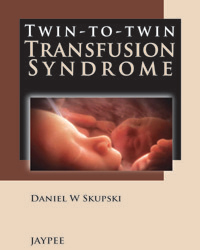|
|
|
| |
 |
|
|

|
-
推薦指數:



|
|
- 內容介紹
|
Twin-to-Twin Transfusion Syndrome
Author:
Daniel W Skupski MD
ISBN 9789350903513
Edition 1/e
Publish Year 2013
Pages 186
Size 8.5" X 11"
Cover Type Hard Back
Quick Overview
The study of fetal medicine encompasses individuals who believe this both instinctively and consciously and have devoted their careers to the study of the fetus and the treatment of fetal diseases. It is these individuals who have moved forward the knowledge about twin-to-twin transfusion syndrome (TTTS) and our ability to treat this devastating disease. The story of medical efforts to tackle TTTS exemplifies how many important areas of medicine have begun to coalesce recently, including ethics, basic science discoveries, innovation in medical equipments, and clinical collaboration of investigators. Some of that story will be told throughout this book. I believe you will find that this story is compelling. Creative ideas in this book do not spring from my mind, but come from numerous individuals. The credit for the ideas that move us forward and save fetal lives goes to many. This book, and the advances in fetal medicine that have produced continually increasing survival and continually decreasing morbidity for fetuses suffering from TTTS over the last 30 years, is truly the result of a team effort.
DOODY'S BOOK REVIEW
REVIEWER'S EXPERT OPINION
Anthony Shanks, MD (Washington University School of Medicine)
Description
This is a comprehensive reference on a single, specific obstetrical complication -- twin-to-twin transfusion syndrome (TTTS).
Purpose
The book presents the history of TTTS as well as techniques for diagnosing and treating the condition, in an evidence-based format that is easy to understand.
Audience
It is intended for those with an interest in high-risk pregnancies, but fellows and attendings in maternal-fetal medicine are likely to find it the most beneficial. I am not familiar with the international authors, but Dr. Moise is an undisputed authority on the subject.
Features
The book begins with an interesting jumping-off point: "Where did we come from?" Unlike other books of this type, this one takes a more historical perspective, which makes it an interesting read and helps readers appreciate the topic that much more. Middle chapters focus on the pathophysiology, and the text and illustrations provide sufficient heft to this section. Throughout it all, the book maintains an evidence-based format with very recent and pertinent references. This was illustrated particularly well in the description of TAPS and TOPS. There are chapters devoted to aspects that I had not previously considered (despite reading many different books on the subject) - for example, maternal nutrition and the cervix. These are great examples of going further than a simple summary manuscript. Certainly, a good portion of this book is devoted to treatment and outcomes and it does a good job, as well.
|
|
|

